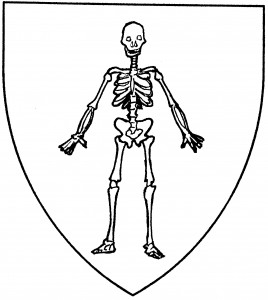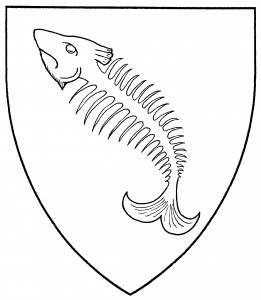A skeleton is the framework of bone supporting the body’s tissues. The default skeleton is that of a full human figure; as with all other human figures, it is statant affronty by default. The human skeleton is found in the civic arms of Londonderry, 1613 [records of Chief Herald of Ireland]. Lesser portions of the human body (e.g., arms) may also be skeletonized in Society armory.
There are also period examples of “fish skeletons”, in the canting arms (German Gräten) of Gradener or Gradner, c.1460 [GATD 19]. The illustration shows a fish’s skeleton bendwise. More exotic skeletons, such as a bird’s skeleton, are deemed a step from period practice; in some cases (e.g. “dragon’s skeletons”), they have been ruled unidentifiable and thus unacceptable.
For related charges, see skull.
The Shire of Loch Báis bears: Per fess azure and sable, a laurel wreath Or sustained by a skeletal cubit arm palewise argent.
Soshka Gregor’evich Vilanov bears as a badge: A human skeleton argent crowned with a pearled coronet Or.
David Fisch bears: Sable, a fish skeleton bendwise sinister embowed argent.

